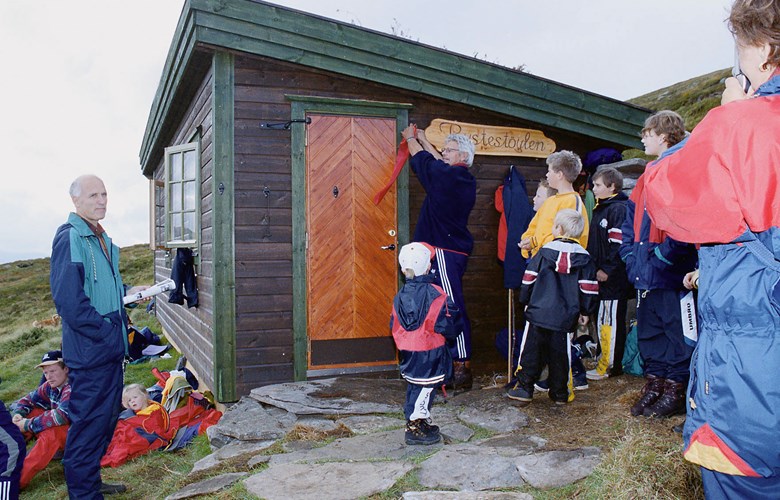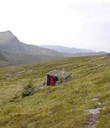Mountain farm for the farms at Raudeberg
Rystestøylen was a common grazing area for the farms at Raudeberg. There could be as many as 40 milk cows. When the operation was at its peak, there could be up to ten girls from the various farms of Raudeberg who hiked up into the mountains. From the age of eight to ten, they started to accompany grown-ups to give a hand. This was one of the chores the girls had. Girls from the farms of Sørgardane, Sivertane, Holmane, Vetrhusane and the others started from their own farms and met at Kvila (literally: the resting place) and continue further up together. When they came to a resting place called Melten, the youngest girls were usually left there to make coffee, while the older ones went looking for the cows. They kept cups and coffee pot in a box there. Some big rocks were gathered to make an open fireplace. Coffee tasted especially good in the mountains. Instead of cream they used something locally called "frøde", which means milk foam. They had brought with them open sandwiches, thick pancakes and potato pancakes. The cows frequently grazed at Kvalheimsbakkane or Svartebotn. Many a time they had to go and look for the cows. When the weather was warm and dry, the cows sometimes went down all the way to Neset.
Early to rise
The girls went up into the mountains every morning and evening six days a week. They had Sundays off. Then their parents usually took care of the work. A cowshed at Rystestøylen was built in 1946, but the cows had been up in the mountains before that time. The girls left home shortly before 5.30 in the morning. It took between 45 minutes and an hour to walk up to the mountain farm. They had to be back at the farm between 8 and 8.30. At 9 the milk truck came from Måløy to pick up the freshly strained milk. Later that day they had to do other chores such as haymaking, making food, washing clothes, and so on. In the afternoon about 5, it was time for another climb up to the mountain farm carrying milk pails and wooden tubs carried on their backs. Now there was less rush. The milk truck did not return until the following morning.
On life at the mountain farm
It could be dangerous to move around in the mountains. At some places, as at Kvenneberget, it was very steep. They had to walk in Indian file and pass the milk pails to each other. The girls wore dresses and soft shoes, and some even walked barefoot. At that time there were many farmers who had workhorses, and in the summer they roamed wild in the mountains. Flocks of up to 20 horses could suddenly turn up at the mountain farm and scare the girls. One year, three heifers fell off a cliff and were killed. The girls were told in no uncertain terms by their parents that they were never to walk below a cow in steep terrain. If the cow lost her footing, she would take the girls with her in the fall. Klara Nybakk was good at calling the cows. "Kom kolla, kubein," she sang. "Kubein" (literally: cow's leg) was salted and dried fish backs that the girls had brought for the cows. These were pounded soft on a rock before they were given to the cows. Dried herring was also another favourite of the cows. The cows could be stubborn and each animal had her own personality. One cow always started to kick once the milkmaid stopped singing. Another cow was choosy as to who could milk her.
The end about 1950
In he autumn when the animals were to be fetched down from the mountains, there was a party with sour-cream porridge for everybody who had taken part in the milking that summer. This party was organized on a rotation basis among the Raudeberg farms. About 1950, the tradition of taking the cows up into the mountains finally came to an end. In the last few years, there were not many farmers who took their animals up to the mountain pastures, and in 1952, Agnes Johnsen was alone at Rystestøylen. Many farms had changed from cows to sheep, and on many farms the younger generation had taken over and the operation of the farm changed as well.
The foundation Rystestøylen
The "gardfjøs" at Rystestøylen collapsed a few years after the operation was ended. Only the foundation walls remained. In the 1990s, some people suggested that the cowshed should be rebuilt. In 1999, the foundation Rystestøylen started on this work. The old cowshed had enough space for seven cows. The rebuilt house measured 21 square metres and could accommodate seven people. An important motivating factor for those who worked on this project was that they wanted a monument to the work that had taken place at the mountain farm. In addition, they wanted to create a meeting-place in the mountains in order to encourage people to open-air leisure activities such as hiking. People could also learn something about the history of the mountain activities. In the new house, it is possible to stay overnight and there are cooking facilities. People put in a total of 600 voluntary man-hours on this project. The foundation also marked two trails from Raudeberg up to the mountain farm. One starts at Leite and the other one starts from Øvrevegen, a little further to the south in the village.



